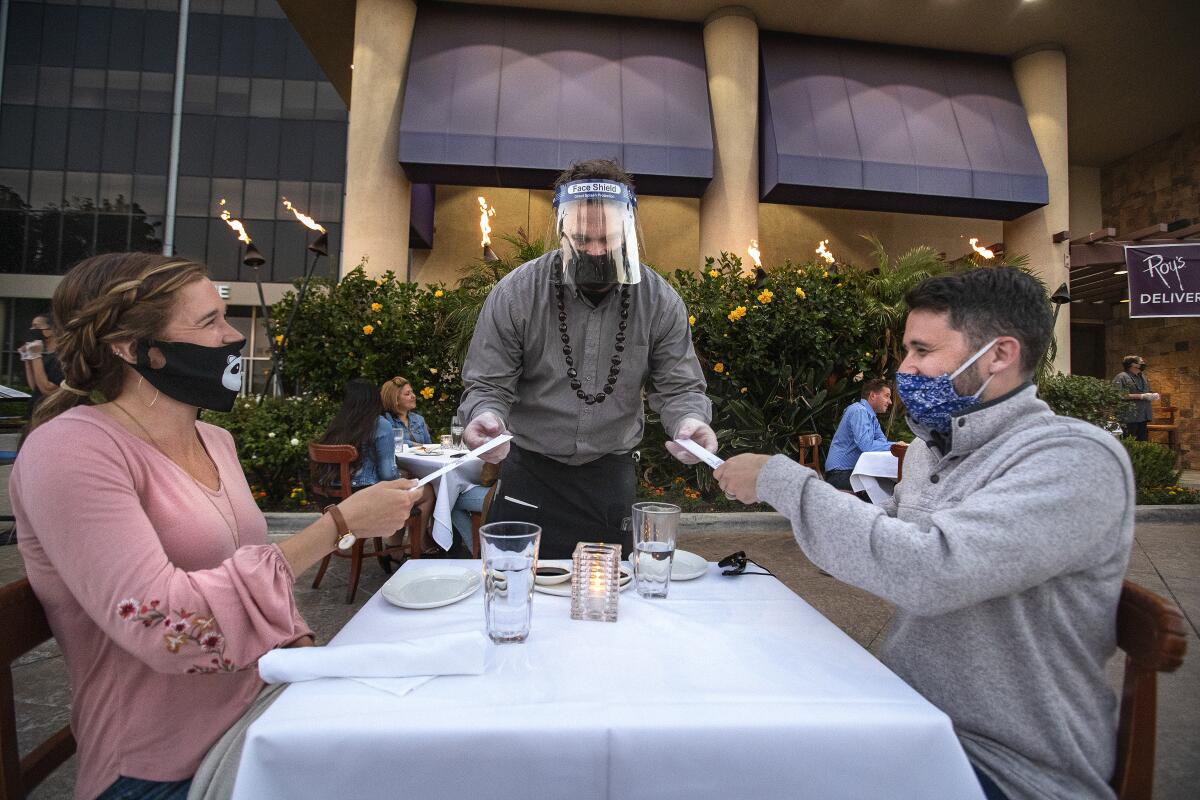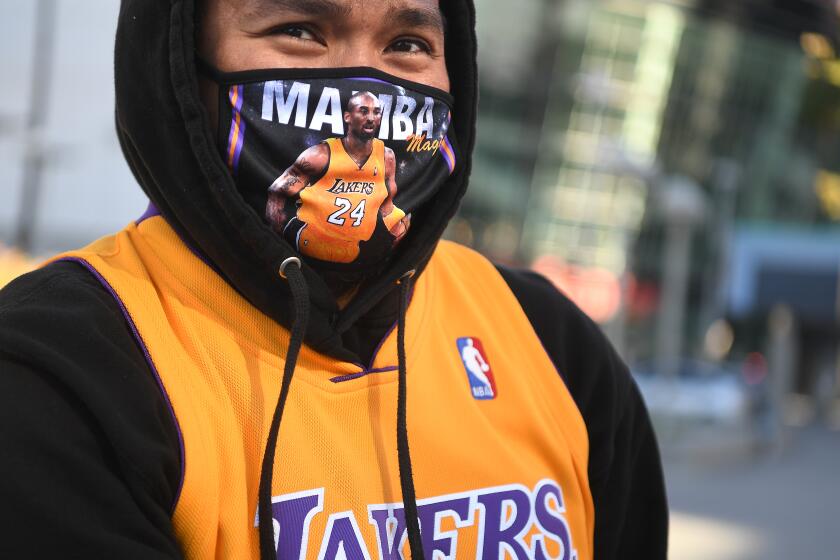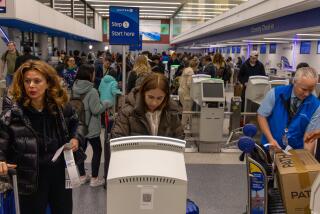Why uncovered faces are oh-so risky as California reopens and coronavirus variants spread

- Share via
SAN FRANCISCO — As public health experts debate the wisdom of California’s decision to ease coronavirus restrictions, they are warning residents to step up precautions now that highly contagious variants and a still-high positive test rate have combined to create “a more dangerous world.”
“We will have to be doing a major education effort to make sure people do not misinterpret the removal of the regional stay-at-home order and think they can go about their lives like they did before COVID,” said Dr. Robert Kim-Farley, a UCLA medical epidemiologist and infectious-diseases expert.
“Otherwise,” he said, “we will see these numbers just go right back up.”
Experts who believe looser restrictions were justified point to positive trends.
New cases and hospitalizations have plummeted from a December high, and no holidays are approaching that will put pressure on people to gather, they note. Many mask scofflaws may already have become infected and obtained some immunity, posing less of a danger to others, and vaccines continue to roll out, albeit slowly.
But the cautious optimism remains tempered by how widespread the virus remains in California, complicated by the new variants found here and elsewhere in the nation. The federal Centers for Disease Control and Prevention has predicted that a variant from the United Kingdom, which is substantially more infectious and likely more deadly, will become the dominant U.S. strain by March.
Masks have been effective in slowing the coronavirus’ spread, but there has been debate about whether one-layer cloth masks offer enough protection.
Dr. John Swartzberg, a UC Berkeley infectious-disease expert, believes California ended the regional order too soon.
“If the question is saving the maximum amount of lives, projections suggest that we will suffer far fewer deaths between now and June if we persist in the lockdown,” Swartzberg said. “I’m not talking about a prolonged lockdown. Even an additional few weeks will make a big difference in terms of lives saved.”
Swartzberg said the state’s decision Jan. 25 to end the regional order, allowing restaurants to offer outdoor dining and other places to reopen, followed a now familiar pattern.
“Every time we experience a surge, we lock down, the surge crests, and then starts to decline,” he said. “We open things up too soon (think May and early June followed by the summer surge, and September and October followed by the winter surge), we accept a steady state of new daily cases that is appreciably higher than prior to the surge…. By opening up too soon, we will build on a very high background of daily cases.”
In the meantime, he and other experts say residents, when near others indoors, should wear more protective face coverings — not just single-layer masks or gaiters — and consider protecting their eyes with face shields or goggles.
Trips to the grocery store should be limited and done quickly, Swartzberg said.
“This advice doesn’t cut very well for people who have to go out every day and work in the grocery store,” he added. “For those folks, this has just become a more dangerous world.”
The online MicroCOVID Project, which measures and reports virus risks, says the U.K. strain has increased the risk of infection from a one-time encounter with another person by 50%. The strain already has been detected in Southern California.
Store shoppers should use only rated masks, such as KN95s, and people should wear face coverings outdoors unless they are 15 feet or more from others, says the site, which is perused by many healthcare professionals.
But that advice assumes the U.K. strain is already widespread in California.
Dr. Robert Wachter, professor and chair of the Department of Medicine at UC San Francisco, remains skeptical.
If the U.K. strain was more widespread in California, he said, cases would not have dropped so rapidly during the last two weeks.
Gov. Gavin Newsom established the regional stay-at-home order in December for places where intensive care units were nearing full capacity. With cases and hospitalizations now falling, Wachter said, it made sense to ease the rules. He and other experts noted that most of California remains in the purple tier, the most restricted category for communities where the virus remains widespread.
As for people who think they can let down their guard with the eased restrictions, Wachter said, “I think most people are smarter than that.”
“We are a year into this,” he said, “and if people don’t understand what this virus can do and how to keep yourself safe, it is going to be hard to figure out what message is going to work.”
The U.K. strain is not believed to travel farther in air or to stay longer on inanimate objects, but it attaches better to human cells to get inside and multiply. People infected with it are likely to shed more virus, and those exposed are more likely to be infected.
The vaccines now being distributed protect against the U.K. variant, but a strain from South Africa appears to be more resistant to some of the drugs. Moderna, one of the vaccine makers, is now working on a booster targeted at that mutant. but other strains detected in the United States appear more resistant.
Wachter said wearing face shields or goggles inside stores was a “reasonable” precaution. “It sort of depends on everybody’s level of risk tolerance,” he said.
Physicians at UC San Francisco who treat patients are required to wear goggles as well as masks, whether or not they are dealing with COVID-19 patients, Wachter said. He noted that a study out of China found that people who wore eyeglasses were less likely to get infected.
Although he would be “a little more careful” now if he were not vaccinated, he remains hopeful that adherence to the health rules, the vaccinations and immunity from the already infected may yet spare the state from the massive contagion that hit the United Kingdom.
Here is what you can do — and what you should not do — as COVID-19 restrictions are eased in Los Angeles County.
“At this point, it doesn’t make a whole lot of sense to completely change your behavior based on the variants,” he said. “It makes all the sense now that there are variants to make sure you are not letting down your guard.”
If the variants become more dominant, the calculations change, he said. The new strain in the United Kingdom accounted for 70% of infections two months after it was detected.
“We have to be humble about this,” Wachter said. “This thing is constantly throwing curveballs at us.”
In addition to the U.K. variant, other strains from South Africa and Brazil have been detected in the U.S. Another new variant found in California accounted for 24% of about 4,500 viral samples in California late last year, according to researchers at Cedars-Sinai Medical Center in Los Angeles. The strain had been barely detectable in early October.
A separate analysis of 322 samples primarily from Northern California during late November and December found 25% of the same type. Researchers are now studying the new strain.
Many who have been infected say they followed all the health rules, but Swartzberg said further investigation usually finds there were lapses. He cited the case of someone who once forgot to wear a mask indoors while around others or another person who wears a mask while out walking but is joined by people from outside their household.
The vaccines represent the light at the end of the tunnel, but “the tunnel has gotten very ugly,” said UCLA’s Kim-Farley.
Southern California is recovering from a viral tsunami, its “New York moment,” and many residents know others who became sick or died, he said. That chilling chapter, he added, probably made a strong impression that won’t be quickly forgotten.
“It is better to double down now and make sure all of our family lives, as opposed to be lax now and perhaps losing family members,” he said.
More to Read
Sign up for Essential California
The most important California stories and recommendations in your inbox every morning.
You may occasionally receive promotional content from the Los Angeles Times.













